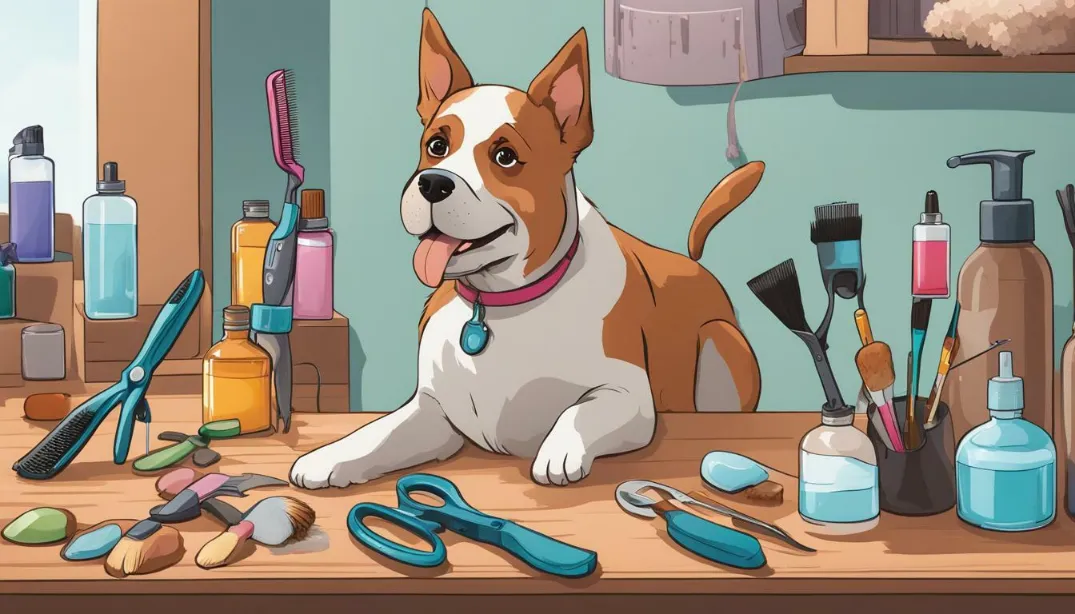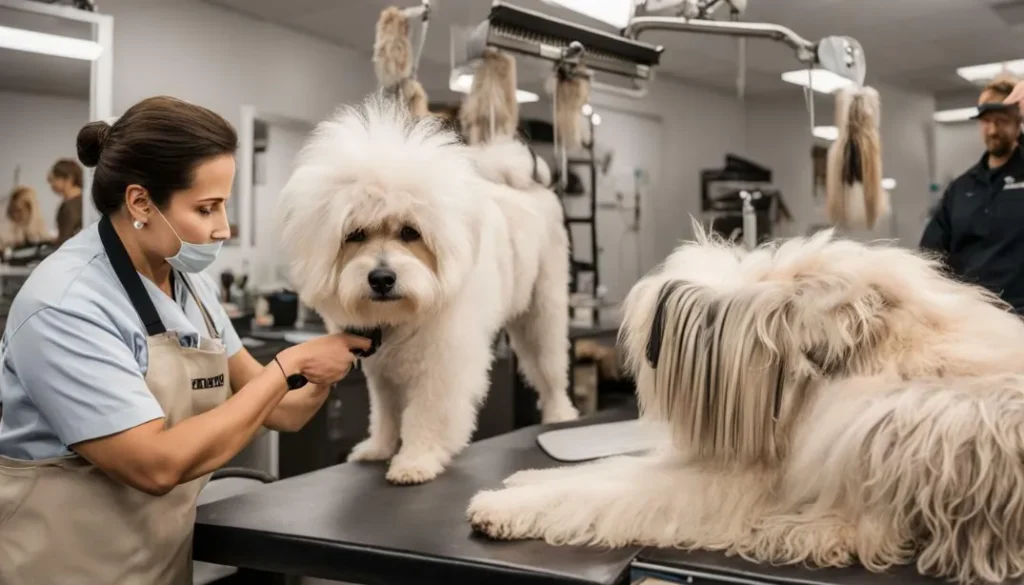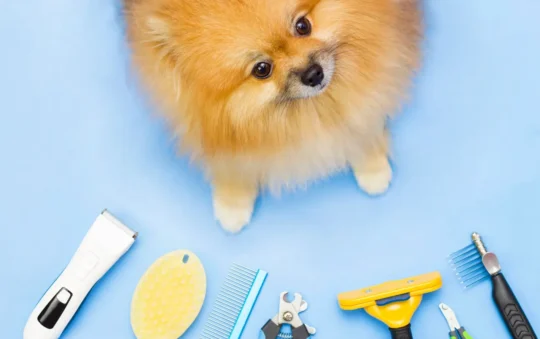Last updated on March 3rd, 2024 at 01:32 pm
If you have a difficult dog and are struggling with their grooming needs, you’re not alone. Dog grooming for difficult dogs can be quite a challenge, requiring specialized techniques and expertise.
Dog groomers who specialize in handling difficult dogs, like K9 Glam Squad, understand the unique difficulties that arise during grooming sessions. These professionals have honed their skills to address the specific needs and behaviors exhibited by these challenging pets. From fear or anxiety to aggression or physical limitations, they know how to navigate through various obstacles to ensure a safe and successful grooming experience.
Understanding Difficult Dog Behavior
Common behavioral issues exhibited by difficult dogs during grooming sessions
Grooming a difficult dog can be challenging, especially when they display certain behavioral issues. One common problem is dog bites, which can pose a risk to both the groomer and the dog itself. These bites can occur in response to fear or discomfort experienced by the dog during grooming. Another issue is when adult dogs become uncooperative and resistant to handling, making it difficult for groomers to perform necessary tasks such as brushing, bathing, or nail trimming.
Puppies may also exhibit difficult behavior during grooming sessions. They might squirm, nip, or vocalize their discomfort through whining or barking. This behavior often stems from the pup’s lack of exposure to grooming procedures at an early age, which can make them an aggressive dog. Some dogs may react negatively to specific sounds associated with grooming tools or equipment, such as clippers or blow dryers. These sounds can trigger anxiety and stress in sensitive dogs.
Factors that contribute to difficult dog behavior during grooming
Several factors contribute to difficult dog behavior during grooming sessions. Firstly, past negative experiences with a groomer can leave a lasting impact on a dog’s perception of grooming activities. If a dog has encountered pain or discomfort during previous grooming sessions, it may develop fear or aggression towards future encounters.
The overall environment and situation also play a crucial role in determining a dog’s behavior during grooming. Dogs are highly perceptive animals and can easily pick up on tension or stress from their surroundings. If the groomer appears anxious or hurried, it can further escalate the difficulty of handling the dog.
Furthermore, individual temperament and personality traits influence how a dog responds to grooming procedures. Some dogs are naturally more sensitive or reactive than others due to genetic predispositions or past experiences.
The importance of patience and understanding when working with difficult dogs
When faced with a difficult dog during grooming sessions, patience and understanding are key qualities for both professional groomers and dog owners. It is essential to approach the situation with empathy and compassion, recognizing that the dog may be experiencing fear or discomfort.
Tips for Grooming Aggressive Dogs
Handling and grooming aggressive dogs can be a challenging task that requires both skill and patience. These dogs may exhibit aggressive behavior due to fear, anxiety, or past traumatic experiences. It is crucial to approach the grooming process with caution and utilize techniques that prioritize the safety of both the groomer and the dog. Here are some tips for grooming aggressive dogs:
Techniques to Safely Handle and Restrain Aggressive Dogs during Grooming
Handling and grooming aggressive dogs require both skill and patience. Here are some techniques to consider:
| Technique | Description |
|---|---|
| Slow Introduction | Allow the dog to become familiar with you and your grooming tools. Avoid sudden movements. |
| Muzzle Training | Train the dog to wear a muzzle before starting any grooming procedures to prevent biting. |
| Proper Restraint | Use grooming loops, harnesses, or gentle leader head collars for security. |
| Gradual Desensitization | Start with less invasive tasks like brushing before moving to complex procedures like bathing. |
| Breaks and Rewards | Take frequent breaks and reward the dog with treats or praise for calm behavior. |
Utilizing Positive Reinforcement Methods to Modify Aggressive Behavior in Dogs
- Counterconditioning: Associate positive experiences with grooming by offering treats, toys, or praise throughout each step of the process. This helps create positive associations instead of triggering aggression.
- Desensitization Exercises: Gradually expose the dog to triggers that may cause aggression during grooming (e.g., the sound of clippers) at a distance where they remain calm. Over time, decrease this distance until they can tolerate these triggers up close.
- Professional Help: Seek guidance from a professional dog trainer or behaviorist experienced in working with aggressive dogs. They can provide tailored strategies to modify the dog’s behavior effectively.
Importance of Using Appropriate Safety Equipment when Dealing with Aggressive Dogs
- Protective Clothing: Wear thick, long-sleeved clothing and gloves to protect yourself from potential bites or scratches.
- Grooming Tools: Choose grooming tools specifically designed for handling aggressive dogs, such as sturdy muzzles, grooming gloves, or grooming tables with secure restraints.
- Secure Environment: Conduct grooming sessions in a confined area that minimizes the risk of escape or injury. Consider using a designated grooming room or a small bathroom with non-slip flooring.
- Emergency Preparedness: Have a plan in place for emergencies, including contact information for nearby veterinarians and knowledge of basic first aid for dogs.
By implementing these tips, groomers can ensure the safety and well-being of both themselves and the aggressive dogs they work with. Remember that patience, positive reinforcement, and gradual desensitization are key factors when dealing with aggression during grooming sessions. Seek professional help if needed to address specific behavioral issues effectively. With proper techniques and equipment, even difficult dogs can have a successful and stress-free grooming experience.
Techniques for Grooming Fearful Dogs
Grooming can be a challenging experience for dogs with fear aggression or anxiety issues. These dogs may exhibit fear-based behaviors such as trembling, hiding, growling, or even snapping when faced with grooming procedures. However, with the right techniques and approach, it is possible to build trust and confidence in fearful dogs before starting the grooming process.
Building Trust and Confidence
Before attempting any grooming procedures on a fearful dog, it is crucial to establish trust and create a positive association with the grooming environment. Here are some strategies that can help:
| Strategy | Description |
|---|---|
| Start Slow | Let the dog explore the grooming area at their own pace. |
| Positive Reinforcement | Reward calm behavior during interactions with grooming tools. |
| Desensitization | Introduce grooming tools gradually, allowing the dog to get used to them. |
| Counterconditioning | Pair scary stimuli with high-value rewards to create positive associations. |
Gradual Desensitization Techniques
Fearful dogs often benefit from gradual exposure to grooming procedures in order to reduce their anxiety levels over time. Here are some techniques that can be employed:
- Baby Steps Approach: Break down each step of the grooming process into small achievable tasks that gradually increase in difficulty. For example, start by simply touching the dog’s fur gently before progressing to brushing or clipping.
- Short Sessions: Keep grooming sessions short initially, focusing on building positive experiences rather than completing an entire groom all at once. This prevents overwhelming the dog and allows them to gradually adapt.
- Systematic Desensitization: Introduce grooming procedures in a controlled manner, starting with the least intrusive actions and gradually progressing to more intense ones. This helps the dog become accustomed to each step without triggering fear or aggression.
Gentle Handling and Soothing Voice Tones
The way we handle fearful dogs during grooming plays a vital role in their overall comfort level. Here are some tips for gentle handling:
- Slow Movements: Avoid sudden movements that may startle the dog. Instead, move slowly and deliberately, giving them time to process each action.
- Use of Restraints: Some dogs feel more secure when gently restrained during grooming procedures. However, it is important to use appropriate restraints that do not cause discomfort or increase fear levels.
- Soothing Voice Tones: Speak softly and use a soothing tone throughout the grooming process. This can help calm anxious dogs and create a sense of security.
Remember, every dog is unique, and what works for one may not work for another. Patience, understanding, and positive reinforcement are key when dealing with fearful dogs during grooming sessions. By employing these techniques, you can help make the experience less stressful for both you and your furry friend.
Handling Challenging Breeds during Grooming
Grooming dogs can be a delightful experience, but it can also present unique challenges, especially when dealing with certain breeds. Each breed comes with its own set of characteristics and temperaments that groomers must navigate carefully.
Breed-Specific Challenges Faced by Groomers
Understanding the specific challenges associated with different breeds is crucial. Certain breeds have distinct coat types that require special attention and care. For instance, double-coated breeds like Huskies or German Shepherds have an outer layer of guard hairs along with a dense undercoat. Groomers must be adept at removing loose fur without damaging the protective topcoat or causing discomfort to the dog.
Special Considerations and Techniques for Challenging Breeds
To effectively groom challenging breeds, groomers must employ specialized techniques tailored to each breed’s needs. Here are some key considerations:
| Consideration | Description |
|---|---|
| Coat Management | Double-coated breeds need regular brushing with tools like slicker brushes or undercoat rakes. |
| Heat Regulation | Brachycephalic breeds require careful drying due to heat-related issues. |
| Patience and Calmness | Some breeds may be anxious during grooming. Stay patient and use positive reinforcement. |
Understanding Breed Temperaments and Adapting Grooming Approaches
A crucial aspect of handling difficult dogs is understanding breed temperaments and tailoring grooming approaches accordingly. Some breeds may be more sensitive to touch or have specific triggers that groomers should be aware of. By studying breed characteristics, groomers can adapt their techniques to ensure a comfortable experience for the dog.
For instance, while some breeds enjoy being pampered and are receptive to grooming, others may require a more assertive approach. In such cases, groomers need to establish trust gradually by starting with less invasive procedures before progressing to more challenging tasks.
Creating a Calming Environment for Anxious Dogs
Anxious dogs can find the grooming process incredibly stressful. As pet owners, it is our responsibility to ensure that our furry friends feel calm and comfortable during these sessions. By creating a soothing environment, we can help reduce their anxiety levels and make the grooming experience more pleasant for them.
Importance of a calm and stress-free environment for anxious dogs during grooming sessions
One of the most crucial aspects is providing a calm and stress-free environment. Anxious dogs are easily overwhelmed by unfamiliar surroundings or loud noises, which can exacerbate their anxiety. Therefore, it is essential to create an atmosphere that promotes relaxation.
To achieve this, consider setting up a designated grooming area at home where your dog feels safe and secure. This could be a quiet room or corner of your house where they can retreat to when they need comfort. Make sure the space is free from distractions and other pets to minimize potential triggers for anxiety.
Utilizing aromatherapy or pheromone diffusers to create a relaxing atmosphere
Aromatherapy has proven effective in reducing stress levels in both humans and animals. Consider using essential oils such as lavender or chamomile, known for their calming properties, to create a relaxing atmosphere during grooming sessions. Another option is utilizing pheromone diffusers specifically designed for dogs. These diffusers release synthetic versions of calming pheromones that mimic those naturally produced by mother dogs when nursing their puppies.
Incorporating soothing music or white noise machines to help reduce anxiety in anxious dogs
Playing soft, calming music during grooming sessions can help drown out external noises and provide a soothing background atmosphere. Alternatively, white noise machines can be used to mask sounds that may trigger anxiety in dogs.
Preparing for Successful Grooming Sessions
Essential Tools and Equipment
Having the right tools and equipment is crucial for success. Here are some essential items you’ll need in your pup’s glam squad:
| Tool/Equipment | Purpose |
|---|---|
| Scissors | For trimming the dog’s coat. |
| Muzzle | Safety measures to prevent bites. |
| Assistant | An extra set of hands for smoother grooming. |
| Coat Condition Products | Improve the condition of the dog’s fur, making grooming easier. |
Proper Planning and Organization Tips
To ensure a successful grooming session with your difficult dog, proper planning and organization are key. Here are some tips to help you stay on track:
- Establish a Routine: Dogs thrive on routine, so establish a regular grooming schedule that works best for both you and your pet. Consistency will help them become more accustomed to the process over time.
- Set Aside Ample Time: Difficult dogs may require more time than usual during grooming sessions due to their behavior or coat condition. Allocate enough minutes in your schedule to avoid rushing through the process.
- Create a Calm Environment: Prioritize creating a calm and quiet space where your dog feels safe during grooming sessions. Minimize distractions such as loud noises or other pets running around.
- Plan Breaks if Needed: If you notice signs of stress or fatigue in your pup, allow short breaks during the grooming session. This will help them relax and prevent overwhelming them.
Clear Communication Channels
In dog grooming for difficult dogs, establishing clear communication channels between groomers, pet owners, and veterinary professionals is essential. Discuss the desired style, any specific concerns, or areas to focus on during the process. Share information about any allergies, sensitivities, or medical history that may affect the session
- Understanding Pet Owners’ Expectations: Effective communication with pet owners helps you understand their desired outcome for the grooming session. Discuss the desired style, any specific concerns, or areas to focus on during the process.
- Collaboration with Veterinary Professionals: If your dog has underlying health conditions or behavioral issues, collaborating with veterinary professionals can provide valuable insights and guidance throughout the grooming process. Share information about any allergies, sensitivities, or medical history that may affect the session.
- Alerting Groomers of Behavioral Triggers: Pet owners should communicate any known triggers that may cause anxiety or aggression in their dogs during grooming sessions. This allows groomers to take necessary precautions and adjust their approach accordingly.
- Post-Grooming Follow-Up: After each grooming session, maintain open lines of communication to discuss how the session went and address any concerns or questions that may arise post-grooming.
By following these tips and utilizing effective communication channels, you can enhance the success of your dog grooming sessions with difficult dogs while ensuring both their comfort and safety throughout the process.
Frequently Asked Questions (FAQs)
Here are some frequently asked questions about grooming difficult dogs:
| Question | Answer |
|---|---|
| How do I prevent my dog from becoming aggressive during grooming? | Establish trust, introduce grooming tools gradually, reward calm behavior, and seek professional help if needed. |
| What if my dog is too fearful to be groomed? | Use desensitization exercises, start slow, and build trust and confidence over time. |
| Are there specific techniques for handling challenging breeds? | Yes, research breed-specific characteristics and consult with experienced groomers. |
| How can I create a calming environment for my anxious dog? | Choose a quiet space, play soothing music, and use aromatherapy or pheromone diffusers. |
| What should I do to prepare for successful grooming sessions? | Gather necessary tools, have treats for positive reinforcement, and give your dog some exercise beforehand. |
Improving the Grooming Experience
Now that you have a better understanding of how to handle difficult dogs during grooming, it’s time to put these techniques into practice. Remember, patience and consistency are key when dealing with challenging behaviors. By using positive reinforcement and implementing the tips and techniques discussed in this blog post, you can greatly improve the grooming experience for both you and your furry friend.









